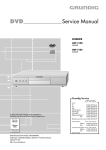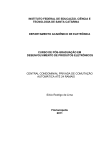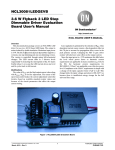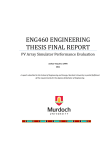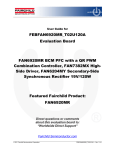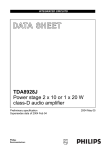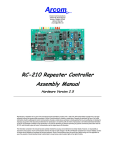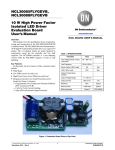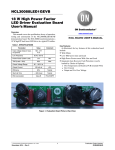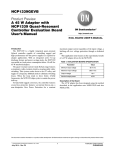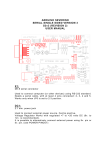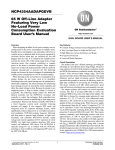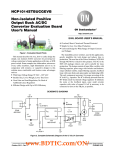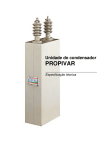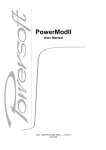Download EVBUM2320 - NCP1370 Evaluation Board User`s Manual
Transcript
NCP1370BGEVB NCP1370 Evaluation Board User's Manual The NCP1370 is a primary side constant current controller. It features a built in control algorithm that allows to precisely regulate the output current of a Flyback converter from the primary side. This eliminates the need for an opto-coupler and associated circuitry. The control scheme also support non-isolated topology such as Buck-Boost and SEPIC. The output current regulation is within ±2% over a line range of 85 − 265 V rms. The power control uses a Critical Conduction Mode (CrM) approach with valley switching to optimize efficiency and EMI filtering. The controller selects the appropriate valley for operation which keeps the frequency within a tighter range than would normally be possible with simple CrM operation. This manual covers the specification, testing and construction of the NCP1370 demonstration board. The board demonstrates a 50-W LED driver for TV backlighting. A dimming circuitry is also provided to show the dimming performances of the NCP1370. The board allows building 2 different power converters: • 200-V Output Voltage with an Output Current of 250 mA • 100-V Output Voltage with an Output Current of 500 mA www.onsemi.com EVAL BOARD USER’S MANUAL Top View Specifications The board is designed to meet the specifications of Table 1. Table 1. LED Driver Specifications Symbol Value Units Minimum Input Voltage Description VIN,Min 120 V dc Maximum Input Voltage VIN,Max 375 V dc Minimum Output Voltage VOUT,Min 175 V Nominal Output Voltage VOUT,Nom 200 V Maximum Output Voltage VOUT,Max 215 V Output Voltage at which the OVP is Activated VOUT(OVP) 340 V Output Current (Nominal) IOUT 250 mA Input Voltage for Brown-In VIN(Start) 110 V dc FSW 100 kHz Switching Frequency at POUT,Max and VIN,Min Bottom View Figure 1. NCP1370 Evaluation Board Description of the Board The board has been designed using the method described in the application note AND9131/D [1]. Figure 2 shows the schematic of the 200-V, 250 mA LED driver which is the default board version. Figure 3 portrays the schematic of the 100-V, 500 mA LED driver. The resistor R12 connected to pin 1 (ILIM) of the controller sets the peak current limit threshold VILIMIT to 2.4 V. A resistor divided formed by R34 and R35 is used to limit the voltage and current in ZCD pin. R16 is the line feedforward resistor that compensates the output current variation caused by the propagation delays. © Semiconductor Components Industries, LLC, 2015 October, 2015 − Rev. 0 1 Publication Order Number: EVBUM2320/D NCP1370BGEVB R23 is used to adjust the output current exactly to 250 mA. A small output capacitor of 470 nF is used in order to have a square output current waveform when PWM dimming is used. The board has a low profile and its height does not exceed 15 mm. R1, R3, R5, R7, R8 and R10 are the brown-out resistors which have been calculated to start operating at VIN = 110 V dc. The controller is supplied by an external power supply. In order to start, the controller needs at least 12 V on VCC pin. The output current is set to 250 mA by the sense resistors R17, R18, R20, R21 and R23. Figure 2. Evaluation Board wit 200-V/250-mA Output www.onsemi.com 2 NCP1370BGEVB Figure 3. Evaluation Board wit 100-V/500-mA Output www.onsemi.com 3 NCP1370BGEVB Valley Switching and Valley Lockout keep the switching losses low. For stable operation, the valley at which the MOSFET is switch-on remains locked until the light demand is changed. Practically, the NCP1370 transitions from quasi-resonant operation to the 2nd valley at low line and from 3rd valley to 4th valley at high line when the LED driver load goes below 80% of its nominal value. A table summarizing the valley transitions can be found in the NCP1370 data sheet [2]. The NCP1370 implements a current-mode, quasi-resonant architecture which optimizes the efficiency over a wide load range by turning on the MOSFET when its drain-source voltage is minimal (valley). Depending on the power supply design, it is possible to achieve almost zero voltage switching as shown by Figure 4. When the light is dimmed, the controller selects a following valley to reduce the switching frequency and VDRAIN VDRAIN VSENSE VSENSE Figure 4. 1st Valley Operation at Low Line, Full Load Figure 5. 3rd Valley Operation at Low High, Full Load VDRAIN VDRAIN Figure 6. 4th Valley Operation at 50% Nominal Output Current, Low Line Figure 7. 6th Valley Operation at 50% Output Current, High Line Output Current Regulation In order to compensate the current variation caused by the propagation delays, line feedforward is needed. The resistor in series with the CS pin R16 adjust the voltage offset on the current sense signal as a function of the input voltage. The capacitor on CS pin C8 must be kept small in order to avoid delaying the current-sense signal and thus increasing the propagation delays. Here a capacitor value of 22 pF was chosen. Because of the line feedforward and also for reason inherent to the constant current algorithm, the obtained output current is slightly lower than the targeted output current. Thus, it may be necessary to adjust slightly the sense resistor by decreasing it. That’s why we added R23 = 33 W in parallel of the other four 3.9 W sense resistors. The output current value is set by the sense resistor RSENSE formed by R17, R18, R20, R21 and R23 on the board. The sense resistor value can be calculated with: R SENSE + V REF 2 @ N SP @ I OUT (eq. 1) Where: • NSP is the transformer turn ratio: secondary turns divided by primary turns • IOUT is the targeted output current • VREF is the reference voltage for constant current regulation www.onsemi.com 4 NCP1370BGEVB Output Current (mA) 255 254 175 V 253 200 V 252 220 V 251 250 249 248 247 246 245 120 160 200 240 280 320 360 Input Voltage (V dc) Figure 8. Output Current Variation for VLED = 175 V to 220 V 265 263 200 V 261 150 V Output Current (mA) 259 100 V 257 255 253 251 249 247 245 120 160 200 240 280 320 360 Input Voltage (V dc) Figure 9. Output Current Variation for VLED = 100 V to 200 V Figure 8 and Figure 9 shows the output current measured when the input voltage is varied from 120 V dc to 375 V dc for different LED string voltages. A Chroma electronic load in LED mode is used to emulate the LED string voltage variation. Looking at Figure 8 where the LED voltage is varied from 175 V to 220 V (roughly 200 V ±11%), we can calculate the mean output current value and the current regulation. www.onsemi.com 5 NCP1370BGEVB DI OUT2 The mean output current is calculated by considering the maximum and the minimum value measured over the output voltage and the input voltage range: I OUT,Mean + + I OUT,Max ) I OUT,Min I OUT2 + 100 @ (eq. 2) 2 253.8 ) 246.8 + 250.3 mA 2 I OUT + 100 @ + 100 @ I OUT,Max * I OUT,Mean I OUT,Mean (eq. 3) 253.8 ) 250.3 + 1.4% 250.3 + I OUT2,Max ) I OUT2,Min (eq. 4) 2 I OUT2,Mean (eq. 5) 260.9 ) 254.6 + 2.5% 254.6 A circuit made of the opto-coupler OC1, the transistor Q2 and some resistors is used to send the digital dimming signal from the secondary side to the DIM pin of the controller on the primary side. By default at start-up, the controller is in OFF mode. In OFF mode, the controller consumes less than 50 mA. The controller leaves the OFF mode when VCC > VCC(on) and VDIM > VDIM(EN). During normal operation, the OFF mode is entered when VDIM stays below VDIM(EN) for 4 seconds. Back to the evaluation board, in order to start, a voltage of at least 3.3 V must be applied on P_DIM connector. For digital or PWM dimming, apply 3.3 V on DRV_ON and apply a square signal varying between 5 V to 0 V with a 200-Hz frequency on P_DIM. By varying the duty-cycle of this signal, the output current will also vary. Figure 10 shows the output voltage and current when dimming with 50% duty-cycle. Figure 11 shows the dimming pin voltage VDIM and the drain voltage in addition to the output current when the dimming signal has a duty-cycle of 10%. The resistors R12 and R11 with the capacitor C4 adds in an extra soft-stop which delays the LED turn-off and compensates the internal soft-start of the NCP1370 and also the time needed for the output voltage to be high enough to turn-on the LED. The output current regulation is thus ±1.4% for a LED string voltage varying from 175 V to 220 V and for the input voltage varying from 120 V dc to 375 V dc. Figure 9 portrays the current variation when the LED voltage is decreased down to 100 V (the nominal voltage being 200 V) in order to simulate the case where several LEDs are shorted. We can see that the current regulation is still good. We have 254.6 mA ±2.5% I OUT2,Mean + I OUT2,Max * I OUT2,Mean Dimming The output current regulation is then calculated as follows: DI OUT + 100 @ 260.9 ) 248.3 + 254.6 mA 2 VP_DIM VDIM VOUT VP_DIM VDRAIN IOUT IOUT Figure 10. 50% PWM Dimming Figure 11. 10% PWM Dimming www.onsemi.com 6 NCP1370BGEVB Figure 12 and Figure 13 show the output current as a function of the PWM dimming signal duty-ratio. The tests were made at 162 V dc. We can observe that the output current is nicely controlled by the DIM pin and the measured current matches the expected value even at low duty-ratio dimming thanks to the soft-stop. 250 Output Current (mA) 200 150 100 Measured 50 Theoretical 0 0 10 20 30 40 50 60 70 80 90 100 Dimming Duty − Ratio (%) Figure 12. Output Current vs. PWM Dimming Duty-Ratio 14 Output Current (mA) 12 10 8 6 4 Measured 2 Theoretical 0 0 1 2 3 4 5 6 Dimming Duty − Ratio (%) Figure 13. Output Current Variation for PWM Dimming Duty-Ration between 1% to 5% www.onsemi.com 7 NCP1370BGEVB Over Voltage Protection/Open LED Protection We chose a 16-V zener diode. As the OVP threshold is 5 V, the comparator will trigger when the voltage on capacitor C6 exceeds 16 V + 5 V + 0.6 V = 21.6 V (0.6 V being the forward voltage drop of diode D1). Figure 14 and Figure 15 show the output voltage waveform in case of open LED. The maximum output voltage is 345 V. On Figure 15, we can see that the output capacitor is discharged down to 0 V after the 1 second timer has elapsed thanks to the dummy output resistor R32. By monitoring the auxiliary winding voltage through D3, D4, R22 and C6, we have an image of the output voltage. By connecting a zener diode from C6 to the VIN pin, we can trigger the over voltage protection (OVP). When pin VIN voltage exceeds 5 V, the controller stops and restarts switching after 1 second. In order to reach 5 V on VIN pin, a current of approximately 900 mA must be injected inside the pin by the zener diode. VOUT VOUT VDRAIN VDRAIN Figure 14. VOUT Waveform in Case of Open LED Figure 15. VOUT Waveform in Case of Open LED after the OVP Timer Has Elapsed In order to decrease the maximum voltage reached on the output connector in case no LEDs are connected to board, the circuit shown in Figure 16 can be used. The maximum voltage reached on the board when no LED was connected was 300 V with this circuit. VCC Q4 2N3906 VIN R102 22k R103 3.9k VDRAIN D3 1N4148 R101 22k R22 22 D2 18V D4 1N4937 VOUT C6 220n Aux Q3 2N3904 R9 4.7k Figure 16. Alternative Circuit for OVP on VIN Pin Figure 17. Open LED with New OVP Circuit on VIN Pin As soon as the zener diode starts conducting, the transistor Q3 is turned on and then bias Q4 which allow pulling the VIN pin high above 5 V immediately. In this case, we need to use an 18-V zener diode instead of a 16-V to avoid triggering the protection during the normal operating range. www.onsemi.com 8 NCP1370BGEVB Test Procedure Equipment Needed: • High voltage dc source: 100 to 375 V dc, minimum 500 W capability • Two dc sources, 30 V • DC Voltmeter – 300 V dc minimum, 0.1% accuracy or better • DC Ammeter – 1 A dc minimum, 0.1% accuracy or better • LED load between 175 V to 215 V at 250 mA. A constant voltage Electronic load is an acceptable substitute as long as it is stable DC Source (5 V Setpoint) DC Ammeter High Voltage DC Source NCP1370EVB DC Voltmeter LED Test Load DC Source (14 V Setpoint) Figure 18. Test Connections: • Connect the high voltage source between inputs “+” and “−” of X1 connector. • Connect a dc power supply between inputs “VCC” and “−” of X1 connector • Connect a dc power supply between inputs 1 and 3 of X3 connector • Connect the ammeter to “LED+” output of X2 connector and then connect the LED load positive terminal to the ammeter and its negative terminal to the “LED−” output of X2 connector Functional Test Procedure: • Set the load at 200 V output • Set the input voltage to 162 V dc • Measure the output current: its value should be within ±2% of 250 mA. www.onsemi.com 9 NCP1370BGEVB Flyback Inductor Specification Figure 19. Flyback Inductor Specification www.onsemi.com 10 NCP1370BGEVB Bill of Materials Table 2. NCP1370 BILL OF MATERIALS Description Tolerance/ Constraint Value Package/ Footprint Reference 1 C1 1 C10 Ceramic Capacitor 47 pF 5%, 1 kV Through-Hole Standard Standard 1 C12 Film Capacitor PET 470 nF 400 V Through-Hole Panasonic ECQE4474JF 1 C2 Electrolitic Capacitor 1 mF 35 V Through-Hole Standard Standard 2 C3, C6 SMD Capacitor 100 nF 50 V SMD0805 Standard Standard 1 C4 SMD Capacitor 1 nF 50 V SMD0805 Standard Standard 1 C5 SMD Capacitor 47 pF 50 V SMD0805 Standard Standard 1 C7 Electrolitic Capacitor 47 mF 450 V Through-Hole Rubycon 12X35 1 C8 SMD Capacitor 22 pF 50 V SMD0805 Standard Standard 1 C9 Ceramic Capacitor 1 nF 1 kV Through-Hole Standard Standard 1 CY1 Y1 Capacitor 1 nF 400 V Through-Hole Standard Standard 5 D1, D4, D5, D7, D10 Standard Diode 1N4148 100 V SOD−123 ON Semicondutor MMSD4148 NC Manufacturer Manufacturer Part Number Qty SMD0805 1 D2 Zener Diode BZX85−C16 16 V DO−41 Fairchild 2 D3, D6 Fast Recovery Rectifier 1N4937 1 A, 600 V DO−41 ON Semicondutor 1 D8, D11 Ultra-Fast Diode MUR160 1 A, 600 V DO−41 ON Semicondutor MUR160 1 IC1 PSR Controller NCP1370B SO−08 ON Semicondutor NCP1370B 1 OC1 Opto-Coupler FOD817B DIL−04W Fairchild FOD817B 1 Q1 Power MOSFET STD8N80K5 1 Q2 NPN Transistor BC847A 5 R1, R3, R5, R7, R8 Resistor 2.2 MW 1 R10 Resistor 6 R11, R12, R19, R27, R29, R35 2 1 8 A, 800 V 1N4937 DPACK ST Microelectronics STD8N80K5 SOT−23 ON Semicondutor BC847AL 1%, 125 mW SMD0805 Standard Standard 100 kW 1%, 125 mW SMD0805 Standard Standard Resistor 10 kW 5%, 125 mW SMD0805 Standard Standard R13, R22 Resistor 22 W 5%, 125 mW SMD0805 Standard Standard R14 Resistor 47 W 5%, 125 mW SMD0805 Standard Standard 1 R15 Resistor 47 kW 5%, 1 W Axial Standard Standard 1 R16 Resistor 2.2 kW 1%, 125 mW SMD0805 Standard Standard 4 R17, R18, R20, R21 Resistor 3.9 W 1%, 1 W SMD2512 Standard Standard 1 R2 Resistor 12 kW 1%, 125 mW SMD0805 Standard Standard 1 R23 Resistor 33 W 1%, 0.5 W SMD2512 Standard Standard 1 R24 Resistor NC 3 R26, R28, R30 Resistor 22 kW 5%, 125 mW SMD0805 Standard Standard 1 R31 Resistor 47 kW 5%, 125 mW SMD0805 Standard Standard 1 R32 Resistor 470 kW 5%, 250 mW Axial Standard Standard 1 R33 Resistor 1W 5%, 250 mW Axial Standard Standard 1 R34 Resistor 22 kW 5%, 250 mW Axial Standard Standard 1 R4 Resistor 10 W 5%, 250 mW Axial Standard Standard 1 R6 Resistor 0W 5%, 250 mW Axial Standard Standard 2 R9, R25 Resistor 4.7 kW 5%, 125 mW SMD0805 Standard Standard 1 TR1 Flyback Inductor Through-Hole Wurth 750315357 1 X1 Input Connector Through-Hole Standard Standard 1 X2 Output Connector Through-Hole Standard Standard 1 X3 Dimming Connector Through-Hole Standard Standard SMD2512 www.onsemi.com 11 NCP1370BGEVB References [1] Stéphanie Cannenterre, Application note AND9131/D, “Designing a LED Driver with the NCL30080/81/82/83” [2] Data Sheet NCP1370/D ON Semiconductor and the are registered trademarks of Semiconductor Components Industries, LLC (SCILLC) or its subsidiaries in the United States and/or other countries. SCILLC owns the rights to a number of patents, trademarks, copyrights, trade secrets, and other intellectual property. A listing of SCILLC’s product/patent coverage may be accessed at www.onsemi.com/site/pdf/Patent−Marking.pdf. SCILLC reserves the right to make changes without further notice to any products herein. SCILLC makes no warranty, representation or guarantee regarding the suitability of its products for any particular purpose, nor does SCILLC assume any liability arising out of the application or use of any product or circuit, and specifically disclaims any and all liability, including without limitation special, consequential or incidental damages. “Typical” parameters which may be provided in SCILLC data sheets and/or specifications can and do vary in different applications and actual performance may vary over time. All operating parameters, including “Typicals” must be validated for each customer application by customer’s technical experts. SCILLC does not convey any license under its patent rights nor the rights of others. SCILLC products are not designed, intended, or authorized for use as components in systems intended for surgical implant into the body, or other applications intended to support or sustain life, or for any other application in which the failure of the SCILLC product could create a situation where personal injury or death may occur. Should Buyer purchase or use SCILLC products for any such unintended or unauthorized application, Buyer shall indemnify and hold SCILLC and its officers, employees, subsidiaries, affiliates, and distributors harmless against all claims, costs, damages, and expenses, and reasonable attorney fees arising out of, directly or indirectly, any claim of personal injury or death associated with such unintended or unauthorized use, even if such claim alleges that SCILLC was negligent regarding the design or manufacture of the part. SCILLC is an Equal Opportunity/Affirmative Action Employer. This literature is subject to all applicable copyright laws and is not for resale in any manner. PUBLICATION ORDERING INFORMATION LITERATURE FULFILLMENT: Literature Distribution Center for ON Semiconductor 19521 E. 32nd Pkwy, Aurora, Colorado 80011 USA Phone: 303−675−2175 or 800−344−3860 Toll Free USA/Canada Fax: 303−675−2176 or 800−344−3867 Toll Free USA/Canada Email: [email protected] N. American Technical Support: 800−282−9855 Toll Free USA/Canada Europe, Middle East and Africa Technical Support: Phone: 421 33 790 2910 Japan Customer Focus Center Phone: 81−3−5817−1050 www.onsemi.com 12 ON Semiconductor Website: www.onsemi.com Order Literature: http://www.onsemi.com/orderlit For additional information, please contact your local Sales Representative EVBUM2320/D












